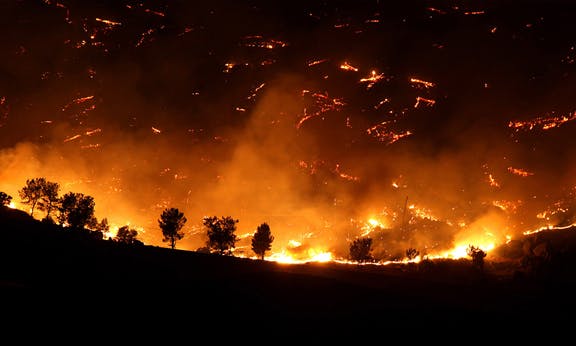Labor throwing fuel on Australia’s summer bushfire threat

The outlook for Australia’s bushfire season is increasingly grim. Already, in late September and early October, many fires were burning out of control. On 3 October, unseasonably hot winds fanned the flames of fires in south-east NSW and north-east Victoria. A number of communities were told in the morning that the fires were approaching so fast it was already “too late to leave”—the best they could do to save their lives was shelter in place.
These were some of the same areas that experienced the worst of the catastrophic bushfires of 2019-20. The terrifying scenes of that summer won’t soon be forgotten: cities and towns all up and down the east coast ringed by flames and shrouded in toxic smoke for weeks at a time; traffic jams of evacuees from fire-hit areas stretching hundreds of kilometres; thousands forced to flee onto beaches and into the ocean to escape the flames; and more than 3,000 homes destroyed and 34 lives lost.
Australian forests have evolved to survive periodic bushfires. They depend on them, in fact, to maintain healthy ecosystems in the long term. In some places, though, the fires of 2019-20 burnt so hot, and the trees were so thoroughly consumed by the flames, that the forests may never fully recover. The same goes for the impacted communities. Many of the thousands of destroyed homes are yet to be rebuilt.
Just four years on from that “one in 100-years” disaster, the conditions already exist for catastrophe to strike again. As the world warms, global weather patterns are becoming increasingly unstable. In Australia this has manifested, among other things, in more dramatic swings between La Niña and El Niño weather patterns.
Under the El Niño pattern, warmer water pools in the eastern Pacific ocean, while water temperatures in the west, around Australia, are cooler. This results in a weakening of the trade winds that blow from east to west along the equator, and reduces the amount of moisture in the atmosphere above Australia’s east coast. The bushfires of 2019-20 came on the heels of an El Niño pattern in the summer of 2018-19, and 2019 was the hottest and driest on record.
Under the La Niña weather pattern, it’s the opposite. The eastern Pacific is cooler, and the water in the west is warmer. A strengthening of the trade winds brings more moisture-laden air over Australia, resulting in significantly above average rainfall and flooding. Between 2020 and 2023 Australia experienced a particularly intense, multi-year episode of La Niña. Huge amounts of rain were dumped along the east coast, with devastating floods hitting southern Queensland and northern NSW, and annual rainfall records being smashed in Sydney and many other places.
All that rain spurred the rapid growth in forests and grasslands, creating new fuel for fires to burn. If the world weren’t on a warming trajectory, this might not be a problem. Under the new reality of the climate crisis, however, it is. Instead of a period of more “normal” weather—during which land management authorities could undertake controlled burns and make other necessary preparations for the bushfire season—the La Niña pattern has now swung back into what looks like a particularly intense El Niño.
Australia is already feeling the effects, with most of the continent experiencing significantly above average temperatures and below average rainfall over the past few months. All that new growth resulting from the above average rainfall under La Niña is rapidly drying out.
The phrase “fiddling while the world burns” has often been used to describe political leaders’ behaviour when it comes to the climate crisis. This gives them too much credit. Our leaders—in Australia today, the Labor Party—aren’t fiddling. They’re throwing fuel on the fire.
The growing bushfire threat hasn’t stopped Labor supporting the expansion of Australia’s fossil fuel industry. This isn’t a case of not doing enough. It’s not as if the government is trying to wind down fossil fuel production, but doing it more slowly than necessary. No, Labor is pushing in the opposite direction—continuing to subsidise the industry to the tune of $11.1 billion annually, fighting court battles against environmentalists to ensure climate effects aren’t considered when approving new coal and gas projects and waging diplomatic campaigns to downplay climate change risks.
Based on the most recent data, Australia is the world’s fifth biggest coal producer, its seventh biggest gas producer and its seventh biggest per capita fossil fuel producer. Ranked by domestic per capita CO2 emissions, it’s ninth. When you factor in the emissions that result from the burning of the vast quantities of coal and gas that Australia exports, it’s clear we’re in the absolute “top tier” of global climate criminals.
As one of the wealthiest countries on Earth, Australia should be leading the way in rapidly cutting emissions and transitioning the economy to renewable energy. The technology exists to do that. Given the hundreds of billions of dollars the government plans to spend in coming decades on tax cuts for the rich and nuclear submarines, no-one can credibly claim that there is a lack of funds. What’s lacking is the political will, and it’s clear that the election of the federal Labor government last year hasn’t resulted in the hoped for change on this front.
Instead of positioning itself, like the previous Coalition government, as a straight-up advocate for fossil fuels, Labor cloaks its policies with layers of green-tinged rhetoric. If anything, this makes it a more effective servant of the industry. To the extent the party has helped end the climate wars, it has done so by helping the fossil fuel barons win. As temperatures continue to climb into the hottest months of summer, communities around Australia are likely, again, to pay a heavy price.